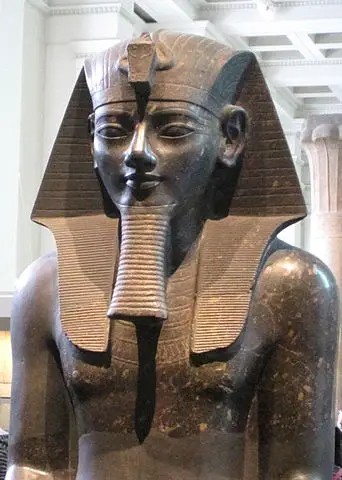Amenhotep III
Who was Amenhotep III?
Amenhotep III was the ruler of Egypt from 1391-1353 BC, and the ninth pharaoh of the Eighteenth Dynasty. He ruled over Egypt during the empire’s peak of power and prosperity, and oversaw a period of great development during his time as pharaoh.
As the son of Pharaoh Thutmose IV (and grandson of the famous Thutmose III), Amenhotep was educated on matters of ruling, religion and government in his childhood, to prepare him for his eventual ascension to the role of pharaoh. He became pharaoh at the age of twelve when his father died, though he had the royal advisor (vizier) rule in his place until he came of age.

Why did Egypt do so well under Amenhotep’s reign?
When he took over, the country was rich and powerful thanks to the work of his father and grandfather – but he took things a step further with his own policies. Amenhotep III was a capable negotiator and politician, and made great strides towards establishing Egypt as a dominant economic power. He maintained his power over the people of Egypt through their faith by weakening the Egyptian priesthood, as well as inflating Ra’s spiritual importance. (The pharaoh was seen as a vessel for Ra’s will at the time.) He also established good trade relations with previously hostile nations, by marrying the daughters of foreign kings of Asia (namely, Syria and Babylon.)
What was Amenhotep III known for?
Amenhotep III is most known for the prosperity of Egypt during his reign, but also for the huge number of monuments built by his people, one of which was the Temple of Luxor in Thebes. The Temple of Luxor became Thebes’ most famous and renowned temples, and one of the grandest structures in the known world – oddly enough, however, it was not dedicated to the worship of Ra, but of Amun, a god whose priesthood Amenhotep himself had weakened!
Aside from the temples built to Ra and Amun, Amenhotep also ordered the construction of many statutes during his reign, mainly of himself and his family; an example of some statues he ordered are the Colossi of Memnon, two 60-foot statues of Amenhotep himself sitting down. Amenhotep has more surviving statues than any other pharaoh, at a whopping 250.
How did Amenhotep III die, and what was his legacy?
Amenhotep III died around 1353 BC, which ended his reign. He was buried in a grand mortuary tomb ordered during his reign, which was later flooded and almost destroyed during a season of heavy rainfall. He was buried alongside his wife Tiye, separate from his other wives.
Following Amenhotep III’s death, his son Amenhotep IV took over as pharaoh. Amenhotep III’s legacy was one of peace and prosperity for the Egyptian people, and a time where development of the arts and architecture was at an all-time high for the civilization. This peace laid the foundation for Amenhotep IV’s rule, which was spent similarly securing trade deals and improving relations between Egypt and its neighbors.
However, like his father, Amenhotep IV made some questionable choices in his role as the religious head of the country. Where his father weakened Amun in favor of Ra, Amenhotep IV weakened all other gods in favor of Aten; a decision which historians believe was encouraged by the faith of his mother, Tiye. Because of this, Amenhotep IV died in disgrace among his people, and was widely erased from historical and cultural records. His father, Amenhotep the Magnificent, remained a bright spot in the dynasty, and went down as one of Egypt’s finest rulers despite his son’s missteps.
Facts about Amenhotep III:
- Amenhotep III was the ruler of Egypt from 1391-1353 BC.
- He ruled over Egypt during the empire’s peak of power and prosperity.
- As the son of Pharaoh Thutmose IV (and grandson of the famous Thutmose III), Amenhotep was educated on matters of ruling, religion and government in his childhood.
- At the age of twelve, he became pharaoh when his father passed away.
- Amenhotep III was a capable negotiator and politician, and made great strides towards establishing Egypt as a dominant economic power.
- He maintained his power over the people of Egypt through their faith by weakening the Egyptian priesthood, as well as inflating Ra’s spiritual importance.
- He also established good trade relations with Syria and Babylon by marrying the daughters of their kings.
- Amenhotep III is also known for the huge number of monuments built during his reign, one of which was the Temple of Luxor in Thebes.
- Amenhotep III died around 1353 BC, which ended his reign.
QUESTIONS:
- For what years did Amenhotep III rule Egypt?
- 1391-1353 BC.
- What age did Amenhotep III become pharaoh?
- 12
- Which two nations did Amenhotep III establish trade links with by marrying into their royal families?
- Babylon and Syria.
- What grand temple of Thebes was built during Amenhotep III’s reign?
- The Temple of Luxor.
- In what year did Amenhotep III die?
- Around 1353 BC.



